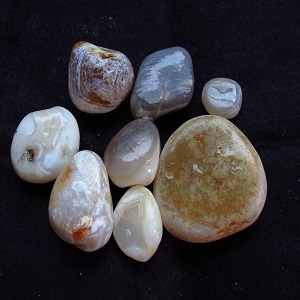?What are the characteristics of turquoise stone

Among the types of turquoise stones, we can mention Shajar and Ajami turquoise. Among the characteristics of turquoise stone, we can mention its attractive color, depending on its color, sky blue or dark blue, it can be very expensive or cheap
Aluminum phosphate turquoise is a translucent to opaque sky blue or green color that contains copper
This stone is known as the jewel of the millennium
The name turquoise is derived from the French word turquoise, which means Turkish stone, because it was first introduced to Europe from Turkey
The color we call turquoise was named after the discovery of this stone
:History of turquoise stone
As one of the oldest stones in the world, turquoise has a long history. Due to its attractive color, at least the sixth and fifth millennia BC, this stone has been noticed and used by humans. Archaeological excavations have shown that three thousand years B.C. Ancient Egyptian rulers used this beautiful gem for cosmetic decoration, talismans, or buried with their mummies. For this reason, its limited reserves in Egypt quickly ran out
Ancient Egyptians used turquoise as a jewelry and decorative stone
The tomb of King Tutan Hamon is decorated with turquoise
The ancient Egyptians believed that the color blue was a symbol of reviving life, so turquoise was used both for decorations and superstitions
Middle Americans made turquoise mosaics and the Chinese used turquoise for decoration
Turquoise was used by Native Americans for jewelry and decoration, some of whom believed that turquoise had the ability to preserve and protect
Tibetans believed in the healing properties of turquoise and considered it a valuable gem for centuries
:Turquoise stone compositions

In terms of chemical composition, turquoise consists of copper and aluminum phosphate
Blue colored minerals are very rare and unique, that’s why the turquoise gemstone is very valuable and has a high price
Blue turquoise jewelry may fade under certain conditions such as prolonged exposure to sunlight, heat, cosmetics, and perspiration; change color
Some turquoise stones have specific veins, which are caused by the conditions of formation of these stones
Turquoises that are well formed and have fewer pores usually have more durability and shine
:Areas where turquoise is found
This stone is formed under the influence of acidic solutions in the water environment and is found in the form of compact masses or separate streaks inside the cracks of the stones in a round or lumpy shape. The best areas in terms of climate for the formation of this stone are dry areas. This gem is usually found in areas where the rocks are left over from volcanic activity or the heat of the earth was involved in its formation. Turquoise is a stone with a porous texture, and the less porosity and bubbles inside this stone, the higher its purity percentage, and as a result, its hardness and strength are higher, and the probability of breakage and cracking for primary extraction or grinding is less. Due to the many pores in this stone, copper and aniline salts can be used to make it beautiful
:This type of turquoise in
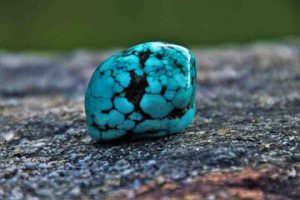
Southwest United States, turquoise
china
Chile
Egypt
Iran
and produced in Mexico
Among the first turquoises found throughout history, we can mention the turquoises used in jewelry discovered in Egypt
These turquoises were found in a royal tomb dating back to 6000 BC
Turquoise is found in cluster-shaped masses in crevices
The best type of turquoise is located in the northeast of Iran
Other reserves are found in Afghanistan, Argentina, Australia, Brazil, China, Israel, Mexico, Tanzania and America
:Turquoise mines in the west
The southwest of the United States is very rich in terms of turquoise stone production, and regions such as Arizona, California, Colorado, New Mexico and Nevada are known as major centers of its production in this country. Currently, Arizona is the largest producer of this stone in the country. Nevada is another American state that, with 120 mines, provides a huge part of the turquoise stone used in the jewelry industry. The best type of it in the United States is obtained from the Los Crilos mine in New Mexico, and before the arrival of the Spanish conquerors to the new continent, the stone of this mine was widely exploited by the natives
:Turquoise in Iran
In the ancient Persian Empire, the turquoise gemstone was hung on the wrist or around the neck and used to protect oneself from unnatural death
The use of turquoise stone in Iran is actually a national heritage that was used to decorate objects, mosques and other important buildings inside and outside the country
Turquoise is an opaque mineral that exists in beautiful colors of blue, green, and yellow
This precious stone is also very old
From ancient times until now, turquoise stone has been used for inlay work and also in making jewelry
:How to identify turquoise

Turquoise can be identified by its sky blue, blue green or apple green color and oil to matte transparency
In addition, its hardness of 5 to 6 makes it stand out from similar gemstones such as chrysocolla, varicite and smithsonite
Its hardness helps to distinguish this stone from similar or mixed samples
The method of identifying the original turquoise
Nowadays, the quality and original type of turquoise stone is very limited in the market. Of course, some of it is marketed as a fixed color that is combined with polymer materials. These types of stones do not change color due to their artificial production and are available in any size. Although oil is considered as a pest of this gem, but fat (paraffin or liquid plastic materials) also makes it shiny and durable, and fills up its pores. In the past, to make this stone look more beautiful, The methods of saturating it with colored oils, wax and colored plastic materials were used. Therefore, by connecting hot metal to these points, a very unpleasant smell of plastic can be smelled. Wax and oil sweat in contact with the hot metal and remain in the turquoise stone. These are usually lighter in weight than their original counterparts. One of the most important ways to recognize natural turquoise is to pay attention to its back, that is, its matrix stone (stone attached to the back of the stone). Neyshabur turquoises, which are dark or white turquoises with pyrite, can help us identify them. In Zachary’s advanced method, American turquoises from the Kingman mine are refined, which is only determined by the device and normally they have no indication as to whether this turquoise has been refined or not! With this method, the strength of turquoise became resistant to both cutting and chemicals. In Iran, the same traditional method is still used
:The degree of transparency and brilliance of turquoise
Turquoise ranges from translucent to opaque, and translucent materials are rare
The transparency of this stone is from oily to matte
Most turquoises have dark gray, brown, or black inclusions
These defects can be dense or scattered
The best type of turquoise is semi-transparent, pure and without impurities
Of course, sometimes these minerals create attractive patterns on the stone, such as the spider web turquoise, which is very beautiful
:Types of turquoise
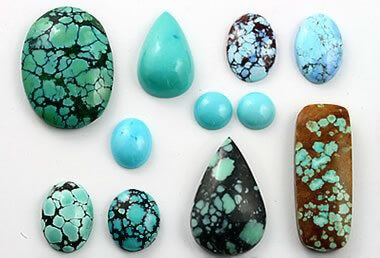
Turquoise is the only gemstone that was introduced with a new color.Turquoise is sometimes combined with malachite or kirzukola, which makes it look green and blue
The turquoise found in America contains more iron than aluminum, so it is a combination of turquoise and chalcosiderite
It is green in color because it contains iron
Pure blue turquoise is rare and usually combined with brown, dark gray or black colors
These colors were created due to minerals or rocks containing turquoise, which are also called bogan turquoise
The most popular turquoise color is sky blue (so called red breast blue or Persian blue), followed by blue-green or apple green
?What is the shape of turquoise and how is it cut
Turquoise is usually cut into wedges for earrings, brooches, necklaces, pendants, bracelets, belts and rings
Its shape is oval or oval
Since one of the gemstones is not very resistant, it is used for decorative carvings
Spherical turquoise beads are useful for bracelets, earrings and necklaces
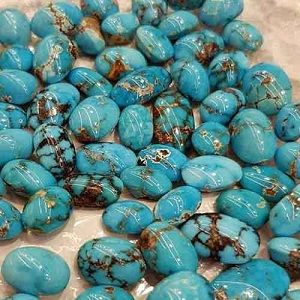
:Turquoise preparation method
Turquoise is a permeable material, so sometimes it is combined with polymer, wax or plastic to make its color more distinctive and its surface resistance more
The turquoise color is improved by using oil or paraffin, various colors or copper salt
Turquoise powder bonded with glass, polyethylene and plastic are combined to make turquoise stones
Neolithic is a fake example of turquoise with a dark bogan, which is called small turquoise
Neo turquoise is another fake type of turquoise with dark bogan
Viennese turquoise is another hybrid example
All jewelers explain the modifications made to the turquoise and the buyer should know if the material is mixed or fake
:Gemological features of turquoise
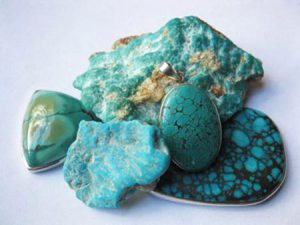
Chemical formula: CuAl6(PO4)4(OH).4H2O copper containing aluminum phosphate
Crystal structure: triclinic (rare), cluster-like
Color: sky blue, green-blue, apple green
Hardness: 5 to 6 on the Mohs scale of turquoise
Refractive index: 1.619 to 1.650
Density: 2.31 to 2.84
Cleavage: None
Luster: translucent, matte
Birefringence or birefringence: 0.040
Transparency: oily, matte
Fluorescence: weak, yellow-green, light blue
Turquoise: similar or related stones
Turquoise is sometimes called lapis lazuli’s cousin because they are similar
Sometimes it is combined with malachite or chrysocolla to get a combined blue and green appearance
The turquoise found in America has more iron than aluminum, so it is actually a combination of turquoise and chalcosiderite
Turquoise is sometimes confused with varicose veins. However, varicose veins are greener
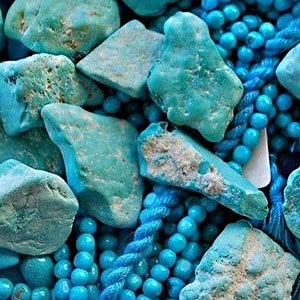
Chrysocolla may also be known as turquoise, but turquoise is harder and has an oily or matte sheen, while chrysocolla has a glassy sheen
Famous turquoise stones
Probably the most famous turquoise is related to the mask that was placed on the body of Tonakh Haman, the king of Egypt
A number of ancient Mesoamerican artworks are on display at the British Museum, including turquoise mosaics such as wooden shields, rain god yogurt and two-headed snakes
The Smithsonian Institute also displays a fascinating collection of turquoise artifacts: a Chinese perfume bottle, a Navajo bracelet, and a Mary Lewis tiara
Napoleon gave this crown to Mary Louise after marriage
The crown was decorated with emeralds, and then in 1950 the gemstones were changed to turquoise, and by Van Cleef & Arpels in 1953, the emeralds were sold separately
Maria Magdalena, Duchess of Vendome wears a turquoise tiara for her wedding to Prince Jean Orléans on May 2, 2009 at Notre Dame Cathedral
Turquoise jewelry is popular with stars like Salma Hayek, Heidi Kalam, Scarlett Johansson, Megan Fox, Blake Lively, Sarah Jessica Parker and Eva Mendes
A gold and turquoise ring belonging to author Jean Austen was purchased in 2013 by American singer Gilly Clarkson
However, an expert sponsored by the British Ministry of Culture allowed the Jane Austen Museum to raise enough money to keep the ring in America
Mrs. Clarkson agreed to resell the ring and it is now kept in the Jane Stein Museum
:How to maintain turquoise
Turquoise jewelry needs more care than other jewelryBecause turquoise jewelry is softer than other jewelry and precious stones such as diamonds and rubies
Of course, due to the softer nature of turquoise jewelry, the use of these jewelry may cause itchy skin, and they are also more prone to breakage and damage
:How to remove turquoise
To take care of turquoise jewelry, we must pay attention to never use soap to clean these jewelry and also avoid contact of turquoise jewelry with grease
To clean your turquoise jewelry, it is better to use warm water and dry it with a very soft cloth immediately after washing
Be sure to note that never use commercial or chemical cleaners to clean turquoise.jewelry

